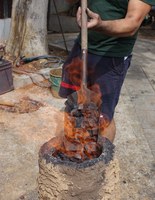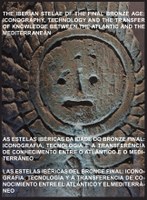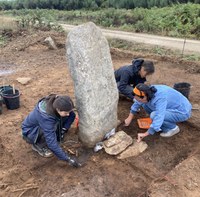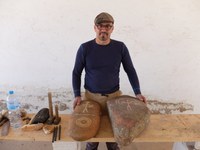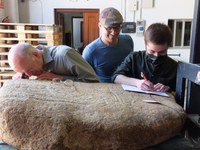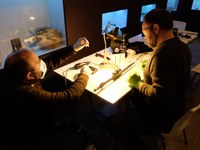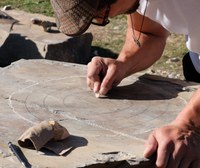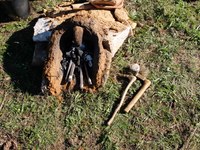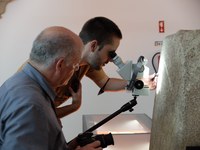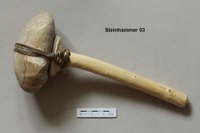Bronzemeißel - Überlegungen zur Herstellung / Bronze Chisels – Approaches Towards their Manufacture / Cinzéis de bronze – Abordagens para a sua manufatura
1.Fragestellungen und Vorüberlegungen zur Rekonstruktion der Meißel
Fragestellung: Wie wurden die bronzezeitlichen Stelen aus hartem Felsgestein hergestellt? Waren diese nur mit Steinwerkzeugen hergestellt, bspw. durch Picken, oder lassen sich diese auch mit Hilfe von Bronzemeißeln herstellen?
Um diese Hypothesen zu überprüfen wird folgendes Experiment durchgeführt:
Es müssen originalgetreue Werkzeuge hergestellt werden, in Bezug auf die Metalllegierung, aber auch in Bezug auf das Metallgefüge.
Das Metallgefüge ist von folgenden Kriterien anhängig:
-
Zusammensetzung des Metalls
-
Abkühlungsgeschwindigkeit
-
Wärmebehandlung
-
mechanischer Bearbeitung
1.Problems and Thoughts on the Reconstruction of Chisels
How and with which tools have the LBA stelae been manufactured from hard rock? Was it only with lithic tools, e.g. by pecking of motives with quartzite choppers, or would bronze chisels also have done the job?
To test our hypotheses on bronze chisels (they do not work, or some alloys do work), the following experiment will be performed:
Authentic models of the LBA chisels have to be manufactured that are true to the original alloys as well as of the original microstructure of the prehistoric metal objects.
The microstructure of metals depends on the following criteria:
1. Composition
2. Cooling rate
3. Heat treatment
4. Mechanical processing
1. Problemas e reflexões sobre a reconstrução de cinzéis
Como e com que ferramentas terão sido as estelas do Bronze Final manufaturadas a partir de rocha dura? Terão sido apenas utilizadas ferramentas líticas, através por exemplo da picagem dos motivos com choppers quartzíticos, ou terão cinzéis de bronze também estado envolvidos neste processo?
Para testar a nossa hipótese dos cinzéis de bronze (se não funcionam, ou se algumas ligas funcionam), será realizada a seguinte experiência:
Modelos autênticos de cinzéis do Bronze Final terão de ser manufaturados de acordo com as ligas originais, assim como com a microestrutura original de objetos metálicos pré-históricos.
A microestrutura de metais depende dos seguintes critérios:
- Composição
- Taxa de arrefecimento
- Tratamento térmico
- Processamento mecânico
1.1. Legierung:
hier können Analysen helfen. In der Regel lag die Zusammensetzung bei CuSn8 – CuSn16. Es werden von jedem Meißel 3-4 Exemplare hergestellt. Die Legierungen, die zum Einsatz kommen sind CuSn10, CuSn12, CuSn14 und CuSn16. Die Werkzeuge werden in den Idealzustand der mechanischen Eigenschaften versetzt. Inwiefern verschiedene andere Zustände sinnvoll sind muss noch diskutiert werden. Ansonsten sind die Gefüge umgewandelt und verfestigt und werden in diesem Zustand zum Einsatz gebracht. Natürlich müssen die Werkzeuge während der Nutzung nach gearbeitet werden. Nach dem Experiment werden die Werkzeuge metallographisch untersucht und mit den Originalbefunden verglichen.
1.2. Formverfahren
Hier ist der Einfluss des Formstoffs zu betrachten. Eine Metallform kühlt das Metall sehr schnell ab, eine offene Form kühlt etwas langsamer ab, eine Sandform kühlt langsam ab und eine Lehmform u.U. noch langsamer. Das Experiment um das es hier geht ist die Herstellung der steinernen Stelen, nicht um die Rekonstruktion des originalen Herstellungsverfahrens der Meißel. Aus diesem Grunde werden die Masse der Meißel im "modernen" Sandgussverfahren hergestellt. Daneben werden aber als Vergleich eine Sandsteinform und einige Lehmformen hergestellt um diese metallographisch miteinander zu vergleichen. Bild 1 uns 2 zeigen die Dauermodelle aus Holz für den Guss der Meißel.
1.1 Alloys:
Analyses will shed light on the alloys of original finds. Generally, LBA alloys ranged from CuSn 8 to CuSn 16 (8-16% tin). Therefore, 3-4 chisels will be cast with each of the following alloys: CuSn10, CuSn12, CuSn14 and CuSn16. The tools will be manufactured in their ideal state of mechanical properties. In as far as other mechanical states could be useful for the experiment will be discussed. Otherwise, the microstructure will be transformed and hardened for their optimal use. The tools will of course have to be refurbished and sharpened during the period of use. After the experiment, the tools will again be analysed with metallography and compared to the archaeological finds to detect corresponding traces.
1.2. Moulding Method
The flow-in of the moulding material is of great importance. A metal mould would cool the alloy down very fast, an open mould would cool a bit slower, a sand mould cools down rather slowly and a clay shape even slower. Since the focus of the experiment is on the replication of stelae with original tools and not necessarily on the prehistoric casting process of the chisels, most of the chisels will be cast in modern sand moulds. However, one sandstone mould and some clay moulds according to LBA models will be used for comparative metallography of the results from these different types of moulds. Figure 1 and 2 show the reusable wooden models for the chisels.
1.1. Ligas
As análises permitirão esclarecer as ligas dos achados originais. Geralmente, as ligas do Bronze Final variavam de CuSn8 a CuSn16 (8-16% estanho). Portanto, 3-4 cinzéis serão fundidos com cada uma das seguintes ligas: CuSn10, CuSn12, CuSn14 e CuSn16. As ferramentas serão manufaturadas no seu estado ideal de propriedades mecânicas. Serão ainda discutidos outros estados mecânicos que possam ser úteis à experiência. Caso contrário, a microestrutura será transformada e reforçada para uma utilização otimizada. Claro está que as ferramentas terão de ser remodeladas e afiadas durante o período de utilização. Após a experiência, as ferramentas serão analisadas novamente com metalografia e comparadas com os achados arqueológicos por modo a detetar traçados correspondentes.
1.2. Método de moldagem
O fluxo do material de moldagem é de grande importância. Um molde de metal arrefeceria a liga muito rápido, um molde aberto arrefeceria a liga mais devagar, um molde de areia arrefeceria bastante demoradamente e um molde em argila arrefeceria ainda mais devagar. Como o foco da experiência é a recriação de estelas com ferramentas originais e não necessariamente no processo pré-histórico de fundição de cinzéis, a maioria dos cinzéis serão fundidos em moldes modernos de areia. Contudo, um molde em arenito e alguns moldes em argila segundo os modelos do Bronze Final serão utilizados para metalografia comparativa dos resultados destes diferentes tipos de moldes. A figura 1 e 2 mostram a reutilização de moldes em madeira para os cinzéis.

Bild 1: Dauermodelle aus Holz für den Sandformguss.
Figure 1: Reusable wooden models for chisels.
Figura 1: Modelos reutilizáveis em madeira para cinzéis.
Bild 2: Die Modelle besitzen die gleichen Dimensionen Fund von Freixianda in Portugal.
Figure 2: The models have the same shape and dimensions as the original find of a LBA chisel from the hoard of Freixianda in Portugal.
Figura 2: Os modelos têm a mesma forma e dimensões que o achado original de um cinzel do Bronze Final do tesouro da Freixianda, Portugal.
1.3. Wärmebehandlung
Nach dem Guss besteht ein dendritisches Gefüge, dieses ist durch das sogenannte Coring, relativ inhomogen (Bild 3). Es ist mechanisch nicht sehr belastbar. Bei gleicher Zusammensetzung, neigt es je nach Korngröße zum Verbiegen oder zum Brechen. Durch die Wärmebehandlung kann das Gefüge normalisiert, d.h. ein Konzentrationsausgleich innerhalb der Dendriten erreicht werden. Dies dauert bei Bronze aufgrund der unterschiedlich großen Ionenradien von Zinn und Kupfer sehr lange.
1.3 Heat Treatment
After casting, there is a dendritic structure of the alloy that is quite inhomogeneous due to so-called coring (Figure 3). It cannot withstand high mechanical load. With the same composition it tends to bend or beak, depending on grain size. Heat treatment can normalize the microstructure by levelling the concentrations within the dendrites. This can take pretty long for bronze because of the differing ionic radius of copper and tin.
1.1. Tratamento térmico
Após a fundição, existe uma estrutura dendrítica da liga que não é homogénea devido ao chamado coring (Figura 3). Esta não consegue suportar uma carga mecânica elevada. Com a mesma composição tem tendência a dobrar ou partir, dependendo da granulometria. O tratamento térmico pode normalizar a microestrutura ao nivelar as concentrações dentro dos dendritos. Este é um processo bastante demorado para o bronze devido ao diferente raio iónico do cobre e do estanho.

Bild 3: Metallographie. CuSn10. Dendritisches Gussgefüge.
Figure 3: Metallography CuSn10. Dendritic casting structure.
Figura 3: Metalografia CuSn10. Estrutura de fundição dendrítica.
1.4. Umformen
Durch den Wechsel von Verfestigung, d.h. mechanischer Deformation des Kristallgitters (=Kaltschmieden) und Wärmebehandlung kann dieses in einen Zustand gebracht werden, das deutlich bessere mechanische Eigenschaften aufweist, als der Rohgusszustand.
1.4 Forming
By changing the solidification or mechanical deformation of the crystal grid (= cold forging) and heat treatment the latter can be transformed into a state that has significantly better mechanical properties than the unfinished casting.
1.1. Formação
Ao alterar a solidificação ou deformação mecânica da rede cristalina (= forjamento a frio) e tratamento térmico, é possível transformar esta última num estado com propriedades mecânicas significativamente melhores que a fundição incompleta.
2. Versuchsaufbau
Es werden Meißel unterschiedlicher Zusammensetzung hergestellt. Um die Versuchsbedingungen konstant zu halten, werden diese im modernen Sandformverfahren hergestellt Es werden pro Legierung jeweils 4-5 Meißel gefertigt. Um das Gefüge der Meißel aus den Sandformen vergleichen zu können wird je ein Meißel zusätzlich in einer Steinform (Sandstein) und in einer Lehmform gegossen. Auf diese Weise kann untersucht werden ob und wie sehr sich das Gefüge der Meißel je nach Formstoff unterscheidet.
Das Metall wird in einem modernen gasbeheizten Schmelzofen geschmolzen und vergossen. Die Schmelz- und Gießbedingungen werden auf diese Weise ebenfalls konstant gehalten und sollten innerhalb der Werkzeuge keine Unterschiede verursachen. Die Metalle werden ohne Kontakt zu Sauerstoff und Wasserstoff geschmolzen jedoch vor dem Guss NICHT wie heutzutage üblich mit Phosphorkupfer entgast, da diese Möglichkeit der Schmelzbehandlung nicht vorhanden war.
Die Wärmebehandlung erfolgt im geregelten Elektroofen Die Gründer liegen auch hier in der Wiederholbarkeit der Prozessschritte. Die Verfestigung der Werkzeuge erfolgt mit bronzenen Werkzeugen (Bild 4).
2. Experimental Setup
Chisels with different composition (CuSn) will be replicated. To keep the experimental conditions constant, they will be cast in the modern sand mould process. 4-5 chisels will be cast from each alloy in sand moulds, and to be able to compare the microstructure of chisels, one chisel from each alloy will be cast each in a stone- and in a clay mould. Thereafter, it can be analysed whether at all and if so in what manner the microstructure of the chisels differentiates depending on the moulding material.
The metal will be melted and cast in a modern gas-fired melting furnace. The melting and casting conditions will be kept constant and therefore there should not be any differentiations between the tools from this process. The metals will be cast without any contact with oxygen or hydrogen, but they will NOT be degassed with phosphoric copper as it is the modern practice today, since this casting treatment was not available in the Bronze Age.
Heat treatment will be performed in a regulated electric furnace. The reason for this is the reproducibility of the experimental process and work steps. The final hardening will be accomplished with bronze tools (Figure 4).
2. Montagem experimental
Os cinzéis de diferente composição (CuSn) serão replicados. Por modo a manter as condições experimentais constantes, serão fundidos de acordo com o processo moderno de molde de areia. 4-5 cinzéis serão fundidos a partir de cada liga em moldes de areia, e para que seja possível comparar a microestrutura de cinzéis, um cinzel de cada liga será fundido num molde de pedra e num molde de argila. Posteriormente será possível analisar se a microestrutura dos cinzéis se diferencia dependendo do material dos seus respetivos moldes e, nos casos afirmativos, de que modo.
O metal será derretido e fundido num forno moderno a gás. As condições de derretimento e de fundição serão mantidas constantes, pelo que não deverá existir qualquer diferenciação entre as ferramentas destes processo. Os metais serão fundidos sem qualquer contacto com oxigénio ou hidrogénio, mas NÃO serão desgaseificados com cobre fosfórico como é pratica moderna atual, uma vez que este tratamento de fundição não estaria disponível na Idade do Bronze.
O tratamento térmico será realizado num forno elétrico regulado. O motivo para esta escolha é a reprodutibilidade do processo experimental e das etapas de trabalho. O endurecimento final será conseguido com ferramentas de bronze (Figura 4).

Bild 4: Spätbronzezeitlicher Amboss nach dem Fund aus Zürich, Wöllishofen und Hammer nach einem Fund aus Hallstatt (Repliken von Bastian Asmus).
Figure 4: Late Bronze Age anvil from Zürich-Wöllishofen and hammer from Hallstatt (replications by Bastian Asmus).
Figura 4: Bigorna da Idade do Bronze Final de Zürich-Wöllishofen e martelo de Hallstatt (réplicas por Bastian Asmus).
Abbildunngsnachweis: Alle Abbildung sind vom Verfasser.
(All photographs and figures by author / Todas as fotografias e figuras: Bastian Asmus)



